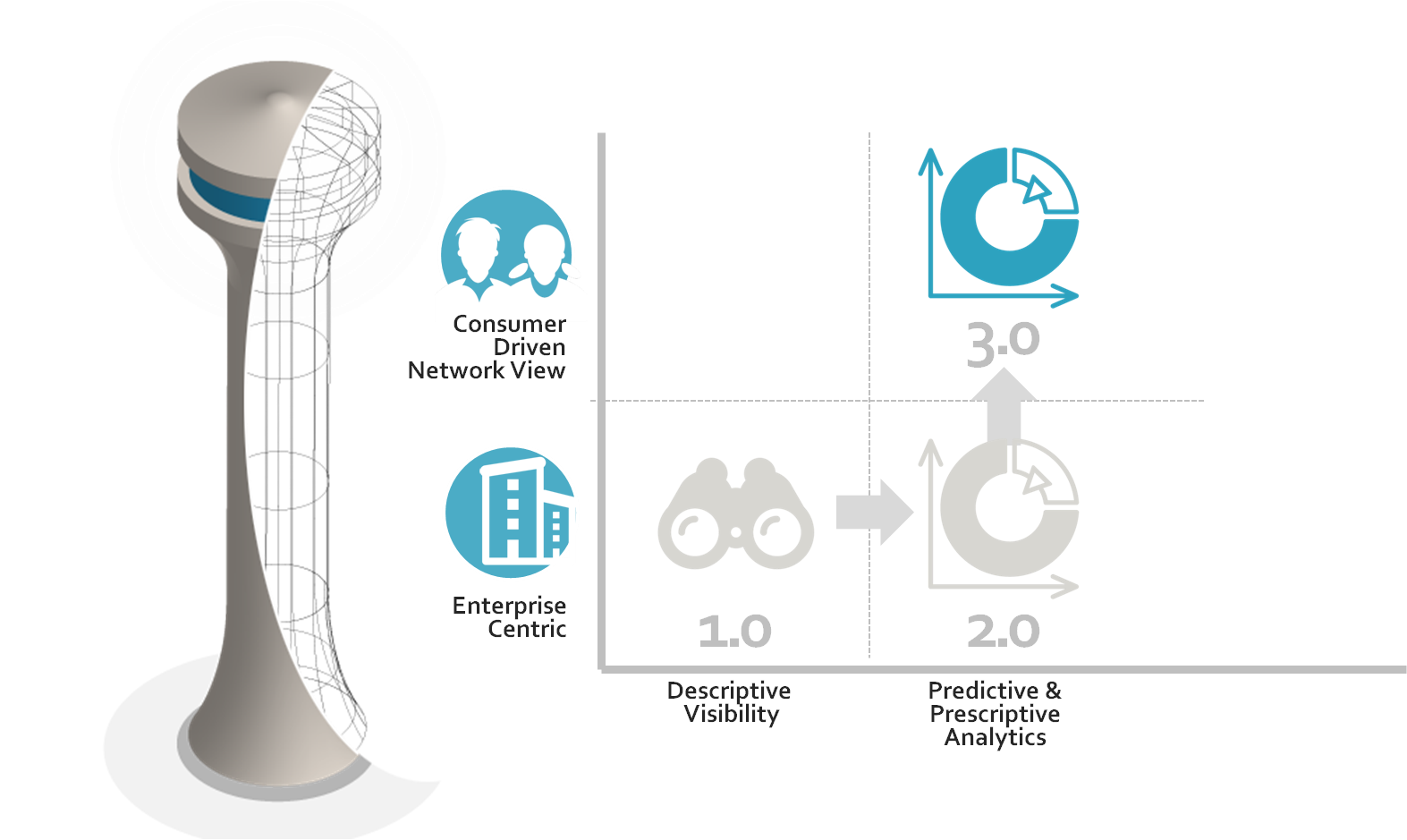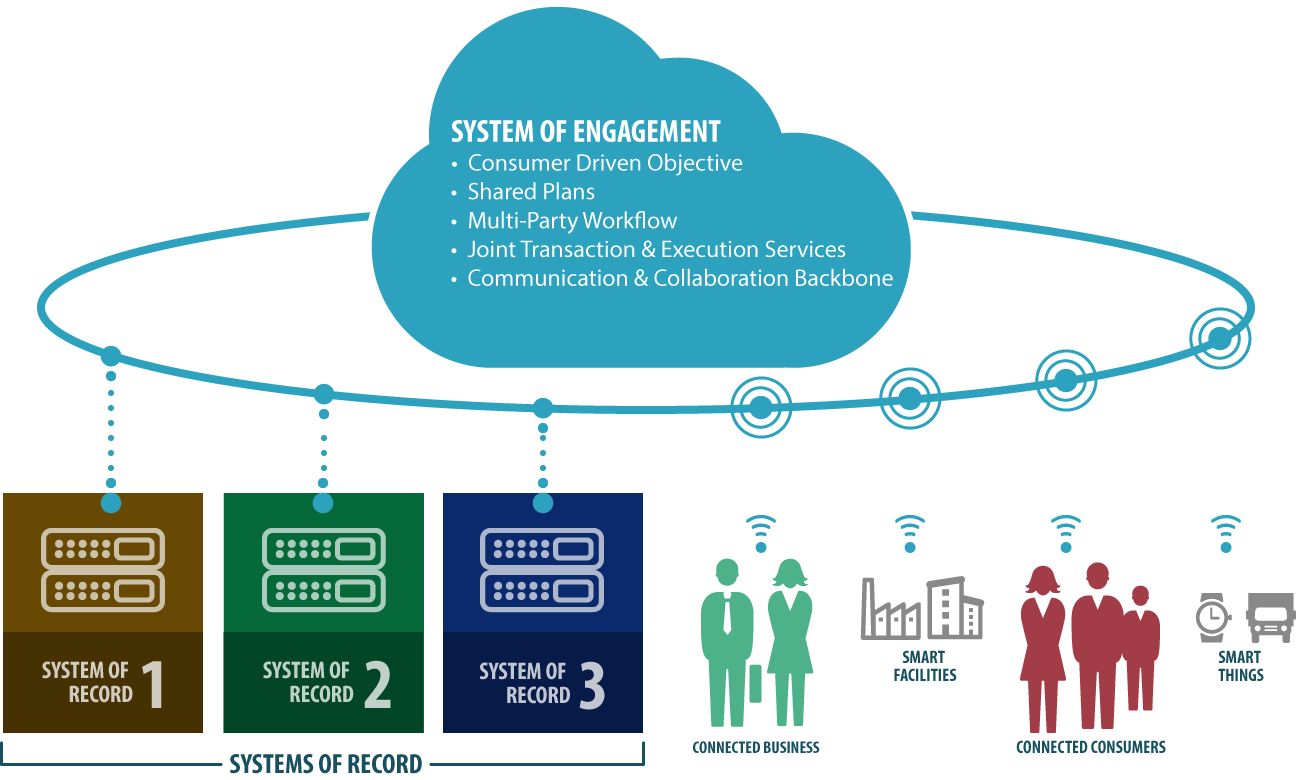This post has already been read 11118 times!
Putting the Consumer at the center of the supply chain universe
In a previous post, Rise of Supply Chain Control Towers, Nigel Duckworth defined the evolution of Supply Chain Control Towers as Control Tower 1.0 and 2.0 and then discussed how these have been instrumental in providing visibility and predictive analytics respectively. However, he also pointed out several limitations with Control Tower 2.0 in terms of operational reach, point-to-point integration, decision support, and ability to coordinate planning and execution across trading partners.
Looking at things from a perspective that is not aligned to their underlying nature creates huge complexity. Share on XI believe these limitations arise from the prevailing “inside-out” view of the world that places our own business at the center, looks out to immediate suppliers and immediate customers next and everyone else only as an afterthought.
In this, the second post within a series on Control Towers, I will discuss why taking an outside-in network view, one that puts the consumer at the center, not only overcomes these limitations but also simplifies the picture and paves the way to achieve breakthrough performance for all parties in the entire value network. I also recommend watching our video, Inside Control Tower 4.0, which goes into a lot more detail on the types of control towers and the benefits of each.
Control Tower 3.0: The Copernican Revolution in Supply Chain

Figure 1: Evolution to Control Tower 3.0 represents a leap from an enterprise-centric orientation to a consumer-centric network view.
Today’s consumer is informed, connected, and fickle. One misstep and she can dump you in a click – and all her friends may know about it instantly. Delighting her requires the entire value network to work in lock-step.
If we pin our focus on the consumer, then we are forced to take an outside-in perspective. We now look at our business and our trading partners as part of a multi-enterprise network that must work together to serve the consumer.
This change of perspective has profound ramifications.
To be clear, I am not talking about just being “demand driven”. Unfortunately, “demand” still connotes what our immediate customers buy from us. I am talking about being consumer driven. This is the greatest shift in the evolution of control towers. Instead of having the enterprise as a central actor looking outwards, the supply chain and trading partner relationships are conceived as a network of equal partners with the consumer being the central focus.
In another post, I have described in more detail the criteria and advantage of true network environments. A true consumer-centric network aligns all parties and all their planning and execution around consumer’s anticipated needs and purchase behavior.
So, how do we get multiple independent businesses to execute together in lock-step? This is the job of Control Tower 3.0.
Systems of Engagement
The Control Tower now acts not merely as a layer of visibility or analytics, but as a System of Engagement (SOE), coordinating execution over the many Systems of Record (SOR) across trading partners.

Figure 2: The System of Engagement connects and orchestrates Systems of Record, people, and smart things.
According to Forrester, Systems of Engagement focus on people not Processes. These new systems harness a perfect storm of mobile, social, cloud, and big data innovation to deliver apps and smart products directly in the context of the daily lives and real-time workflows of customers, partners, and employees. The Control Tower orchestrates all actors (people and things) across multiple companies in real time to serve the consumer.
Control Tower 3.0 and Multi-Party Orchestration
Here are some of the ways Control Tower 3.0 enables multi-party orchestration.
Consumer-Driven Objective
The entire network has visibility to the end customer, and so can respond immediately to resolve problems as they begin to emerge, ensuring supply meets demand as efficiently as possible. Whether it is an unexpected spike or lull in demand, distributors, suppliers and logistics service providers can reallocate inventory and resources to take advantage of the changing conditions. The key here is that all parities are aligned around a shared objective to serve the consumer. This delivers value to all, even as individual parties may optimize their own goals. It brings an overarching shared objective and enables network-wide optimization as opposed to sub-optimized silos working in isolation.
Multi-party workflows
With SOR, it is practically impossible to support workflows that go across multiple companies. A SOE takes the orchestration out of the individual SORs and moves it up to SOE layer which provides a single version of truth and seamless orchestration across all parties and companies. It is a digital network that brings buyer, seller, mover and other parties together to deliver the product to the consumer efficiently, while understanding the constraints of each party and connecting many systems of record.
Joint Transaction and Execution Services
Systems of Engagement also serve as transaction and execution backbone. Transactions can now be multi-party in nature and persisted in systems of record as required. The buying company’s purchase order and the selling company’s sales order are now seen as simply two views of the same transaction – like two sides of the same coin.
Real Time and Agile
The system is real-time and provides data based on actual conditions, allowing all parties to react and resolve issues faster. For example, a supplier is aware as soon as an alert is triggered about a potential stock out. Thus the entire network is more agile and responsive to shifts in demand and to changes in supply. In general, the sooner an issue is addressed, the cheaper the resolution, so this represents big opportunity to cut costs.
In summary, here are the fundamental differences that characterize Control Tower 3.0:
Traditional Approach (Control Tower 1.0 & 2.0) |
Control Tower 3.0 |
| Visibility and control focused on one enterprise | Visibility and control focused on consumer across all parties |
| Inside out | Outside in |
| SORs integrated to each other in chain or hub-spoke arrangements | SOE network layer across SORs, people and things |
| Single enterprise workflows and processes that exchange data with immediate supplier or customer at best | Multi-enterprise workflows and process orchestration |
| Serial, batch execution, one party at a time | Concurrent, real time, execution across multiple parties |
Control Tower 3.0 represents a leap in advancement in control towers. It is virtually impossible to achieve with traditional software, as it requires a multi-party network with a sophisticated and secure permissions framework. Some leading companies have achieved this level of maturity in their journey and are already seeing significant gains.
Value of Control Tower 3.0
The advantages of being consumer-driven in a real-time, network environment dwarf those of the gains in sub-optimized, inside-out silos characterizing 1.0 and 2.0.
This immediately simplifies IT integration as you connect once to the network and are connected to all parties. With a real-time, single version of the truth, you gain clarity and are able to make better, more profitable decisions. You can transact, execute and collaborate across your entire supply network.
Nucleus Research found that multi-enterprise networks can reduce overall costs by 3 to 5%. Nucleus also found:
“[C]ustomers averaged 56% increase in inventory turns and 38 percent decrease in safety stock holdings. Customers benefit from greater visibility, coordination, and optimization within their extended supply chain across multiple tiers of trading partners and suppliers.”
Nucleus Research, “The Real Value of Value Chain Networks,” Seth Lippincott, April 2017
Additional benefits include reduced IT and maintenance costs.
What About My Current Technology?
Does Control Tower 3.0 mean ripping and replacing your System of Record?
No. A System of Engagement extends the value of SORs with rich data and functionality and provides a path to innovate. We will cover this more fully in a later article on what we call “Tunable System of Control” which allows configurable delegation of system authority across a multi party, multi-step workflow.
Also In future posts, we will discuss how Control Tower 4.0 leverages AI, machine learning and cognitive technologies to drive even higher value. Stay tuned.
In the mean time you can learn more about these topics and advanced Control Towers here.
- Why Your Supply Chain Needs Blockchain - March 7, 2018
- What Supply Chains Really are and Why it Matters - November 9, 2017
- What is Machine Learning? - September 29, 2017
